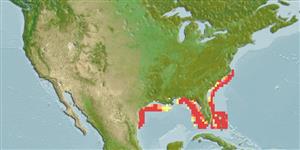| Native range | All suitable habitat | Point map | Year 2100 |

|
| Caulolatilus microps AquaMaps Data sources: GBIF OBIS |
Human uses
Fisheries: minor commercial; gamefish: yes
Phylogenetic diversity index
(Ref. 82805)
PD50 = 0.5005 many relatives (e.g. carps) 0.5 - 2.0 few relatives (e.g. lungfishes)
Trophic Level
(Ref. 69278)
3.8 ±0.5 se; Based on diet studies.
Resilience
(Ref. 69278)
Low, minimum population doubling time 4.5 - 14 years (K=0.14; tmax=15)